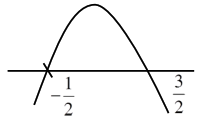Let $f: \mathbf{R} \rightarrow \mathbf{R}$ be defined as
$f(x)=\left\{\begin{array}{ll}-\frac{4}{3} x^{3}+2 x^{2}+3 x & , \quad x>0 \\ 3 x e^{x} & \quad, \quad x \leq 0\end{array}\right.$ Then $f \quad$ is
increasing function in the interval
Correct Option: , 3
$f^{\prime}(x)\left\{\begin{array}{rr}-4 x^{2}+4 x+3 & x>0 \\ 3 e^{x}(1+x) & x \leq 0\end{array}\right.$

For $x>0, f^{\prime}(x)=-4 x^{2}+4 x+3$
$f(x)$ is increasing in $\left(-\frac{1}{2}, \frac{3}{2}\right)$
For $x \leq 0, f^{\prime}(x)=3 e^{x}(1+x)$
$\mathrm{f}^{\prime}(\mathrm{x})>0 \forall \mathrm{x} \in(-1,0)$
$\Rightarrow \mathrm{f}(\mathrm{x})$ is increasing in $(-1,0)$
So, in complete domain, $\mathrm{f}(\mathrm{x})$ is increasing in
$\left(-1, \frac{3}{2}\right)$
Click here to get exam-ready with eSaral
For making your preparation journey smoother of JEE, NEET and Class 8 to 10, grab our app now.
